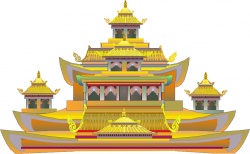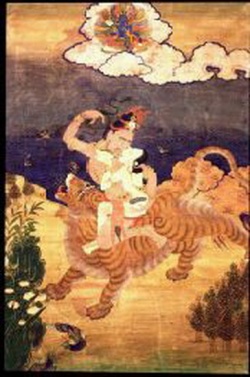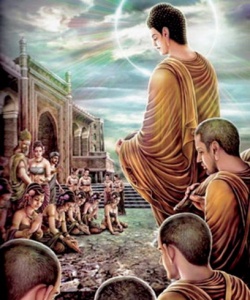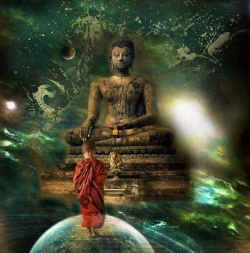Taking Refuge A teaching by His Holiness the Sakya Trizin
The very first step in practicing the Dharma is to take refuge. There are five aspects to taking refuge: the cause of taking refuge, the object of refuge, the way to take refuge, the benefits of taking refuge and, lastly, the rules of taking refuge.
The first aspect, the cause of taking refuge, we have already discussed in the previous issue. So now, we will look at the second aspect, the object of refuge. The object of refuge is the same for all Buddhists, whether they belong to Hinayana, Mahayana or Vajrayana. All Buddhists take refuge in the Triple Gem. But on closer examination, there is a difference. According to Mahayana, and also to Vajrayana, when we say Buddha, we refer to someone who is totally awakened, someone who has become free from all forms of obscurations - the obscuration of defilements and the obscuration of knowledge, including their propensities. Someone who has attained the highest qualities, and who possesses the three kayas.
Of the three kayas, or bodies, the most important one is the Dharmakaya. Dharmakaya means the ultimate truth, or the true nature of all phenomena – it is similar to the Dharmadatu, or ultimate reality, which is totally free of all obscurations. It is also called double purity. Double purity means not only the basic purity that everyone possesses, but also purity in the sense that all temporal obscurations are also totally eliminated. And such a state is realized through awareness, or through primordial wisdom. Such a state, the primordial wisdom that realizes ultimate truth, which possesses double purity, is the Dharmakaya. So that is the most important body. And because They have attained this, the Buddhas have Taking Refuge
A teaching by His Holiness the Sakya Trizin gained all the qualities and have eliminated all forms of obscurations. And so, in order to help sentient beings, and while ceaselessly remaining in this state of Dharmakaya, They appear in a form - but the Dharmakaya is actually formless, it has no form, it is beyond description, it cannot be comprehended by our relative minds.
In order to help sentient beings, the Buddhas, while remaining in such a state, take on a form that is helpful to the pure disciples, the higher followers. For the benefit of the higher followers, the Buddhas appear in the Sambhogakaya form. Sambhogakaya means the body of enjoyment. The Sambhogakaya is said to have the five certainties: the certainty of place, the certainty of time, the certainty of form, the certainty of teachings, and the certainty of surroundings. Here, the surroundings refer to the followers. The place is not anywhere, but always in the highest Buddha Akanishta, the Buddha Field that is known as Akanishta.
Here, there is no time, there is no such thing as birth or death, but it is there all the time, constantly remaining in the form of the Buddha. It does not appear in different forms, but always in the Buddha’s form, the fully enlightened Buddha’s form, adorned with the thirty-two signs and eighty qualities. And it does not impart different teachings, but always the highest Mahayana teachings. And the disciples are not ordinary persons but Bodhisattvas, the highest Bodhisattvas, Bodhisattvas who are already on the stage of the ten bhumis. In other words, the Bodhisattvas who have already gone beyond the worldly path. So it is that the Sambhogakaya has the five certainties.
And then, in order to help ordinary sentient beings, the Buddhas appear in Nirmanakaya form. This is different from the Sambhogakaya, in the sense that when there are worthy followers, the Nirmanakaya appear. When there are no worthy followers, they do not appear, but enter into Paranirvana. The form is not necessarily in the Buddha's form, in that whenever, wherever, and whatever form is required, the form will appear that is most beneficial to that particular situation, to that particular circumstance.
The Buddhas will appear in that particular form to help sentient beings. So the historical Sakyamuni Buddha is also actually a Nirmanakaya. But He's known as an excellent Nirmanakaya because even ordinary persons saw Him as a Buddha with the thirty-two signs and the eighty qualities and so forth.
So the Buddha is the first object of refuge. The second object is the Dharma. ‘Dharma’ is a Sanskrit word and it has many different meanings but here, we are referring to the Holy Dharma. The Dharma has two aspects. One relates to the teachings of the Buddhas and Bodhisattvas who have attained a high realization, wherein They describe and explain to disciples the meaning of this realization. This is the Dharma of teachings.
The teachings are one Dharma, but they are divided into different categories, for example according to subject or time, but normally they are presented as the Tripitaka. Tripitaka means 'Three Containers'. The purpose of teaching the Dharma is to subdue, to tame the defilements. And so, in order to subdue desire, the Buddha taught the Vinaya, the first Container, which explains all aspects of moral conduct, for instance, the lay and monastic vows. Then, the second Container is called the Sutra.
The Buddha taught the Sutra, which explains all the meditations and the different levels of meditations, in order to subdue hatred.
Then, to subdue ignorance, the Buddha taught the third Container, the Abhidharma, which explains wisdom, or ultimate truth.
So this is one aspect of the Dharma, the aspect of the teachings of the Buddha. In fact, the real Dharma is contained in the realizations that the Buddhas and Bodhisattvas have attained, and in the fact that They have permanently eliminated all obscurations. This is the Truth of Cessation.
The real Dharma is also the Path that leads to the Truth of Cessation. The path that leads to uncontaminated primordial wisdom, that becomes a direct antidote to the obscurations, is the Truth of Path. The Truth of Cessation and the Truth of Path, the last two of the Four Noble Truths, are another aspect of the Dharma. They are the true Dharma.
The Tripitaka is just a teaching that is given, while the real Dharma is the genuine Truth that is realized by the Buddhas and the Bodhisattvas. This is what we take refuge in, so the second object of refuge is Dharma.
And then the third object of refuge is the Sangha. The word 'Sangha' actually means 'Community'. So the Sangha means anybody, from the highest Bodhisattva down to the ordinary person, anybody who has entered the Buddhist path. But the true Sangha are the Bodhisattvas who have already gone beyond the worldly path, and who have already reached the irreversible state, who are sure to advance on the path to Buddhahood. These are the true Sangha. So these are the three objects of refuge: the Buddha, the Dharma, and the Sangha.
And now the third aspect is the way we take refuge. The way we take refuge is by taking the Buddha as our guide. Even in ordinary life, if we’re embarking on a new enterprise, we need someone to guide us through.
in the Buddha as guide and teacher on our path. But although the Buddha has great power, it is not by using His power alone that He can save sentient beings. If we constantly commit negative deeds, whatever blessings we receive from the Buddha can just bring us temporary solace. This has nothing to do with the Buddha’s teachings. Rather, in order to help beings, the Buddha shows us what is right and what is wrong, He teaches us how to remain on the right path. The Buddha said: “I have shown you the path to liberation”. Whether or not we follow this path is up to us. We also take refuge in the Dharma. Refuge in the Dharma is our actual path, the real saviour.
For example, when we are ill, it is important to have a good doctor, but we must also make an effort to follow his instructions, to take the medicine that he has given us, and to avoid conditions that will inhibit our recovery. Similarly, the Buddha is like a doctor, and the Dharma is like the medicine. And, as we must take medicine, we must practice the Dharma in order to recover from our samsaric state. We talk about the “Wheel of Dharma”. As the wheel of Dharma turns, the Buddha’s teachings and His wisdom are transferred to the disciple. It is then up to the disciple to put these teachings into practice, and this way progress along the path. Every time the wheel of Dharma turns, we receive new teachings, we put them into practice, and we progress further along the path.
And we take refuge in the Sangha, our companions along the path. For example, if we are undertaking a long and arduous journey, it is important to have worthy companions. Whatever our endeavour, it is always helpful to be accompanied by like-minded persons who share our goals and aspirations. In the same manner, when we embark on the path of Dharma, it is very beneficial to depend on fellow practitioners, so we take refuge in the Sangha. This is the way we take refuge.
As I mentioned earlier, we normally explain the refuge according to five aspects. The first one is the cause of refuge, which is fear, faith and compassion. The second is the object of refuge, which is Buddha, Dharma, Sangha. And the third is the way we take refuge, how we take Buddha as our guide, Dharma as our actual path, and Sangha as our companions. Now the fourth aspect is the benefit of taking refuge. The benefit of taking refuge is said to be enormous.
Even by merely hearing the refuge, even by merely hearing the name of the Buddha, we can gain an enormous amount of benefit. So if, with very sincere devotion and faith, we take refuge in the Buddha, Dharma and Sangha, the merit that we earn is immeasurable. If it had a physical form, even the whole of space would be too small to accommodate such a huge amount of merit. And then also, by taking refuge, we change from the ordinary path to the Dharma path, from the wrong path to the right path. And also we change from being a non-Buddhist to a Buddhist. By taking refuge, we become real Buddhists, not just in name but from our very core, and the Dharma protectors look after us.
The fifth aspect is the rules of the refuge. For example, if we take refuge in another country, then we must abide by the rules and regulations of that country. If we do not keep the rules and regulations of the country that is giving us shelter, then of course we get into trouble. So similarly, after taking refuge in the Buddha, Dharma and Sangha, we also have to observe the rules of this refuge. There are general rules and specific rules to the refuge.
The general rules are five. The first one is that, no matter what, even at the cost of our life, we should never give up the Triple Gem, the Three Precious Jewels, the Buddha, Dharma, and Sangha. Second is that, whatever happens, whatever need arises, we should not seek other means, but always seek the guidance and the blessings of the Triple Gem. And the third one is to make offerings to the Triple Gem on a daily basis, and if this is impossible, then at least on special occasions. If we have a shrine, then it is important to make daily offerings, such as water offering, flowers, incense, fruit, etc. If we do not have a shrine, then we should make offerings in the temple, especially on special days, such as full moon and new moon days and, more importantly, on the Buddha's special days, such as that of His Birth, His Enlightenment, His Descending from the Heavenly Realms, Dharmachakra day, and so forth. And then, the fourth rule is to practice refuge very diligently.
Even though it is important to recite the refuge lines, 'I take refuge in the Buddha, I take refuge in the Dharma, I take refuge in the Sangha', these words alone are not enough to lead us to liberation, unless they come from the depths of our hearts. When we truly take refuge in the Triple Gem, it means that we are totally submitting ourselves to the Buddha, Dharma and Sangha, that we rely entirely on their guidance. For example, if we need to escape from the rain and we seek a cave to give us shelter, it won’t help us much to recite “cave”. Rather, in order to be safe from the rain, we make the effort to find shelter in a cave, or in a house, so that we’re spared from the rains.
So similarly, although recitation is also important, the crucial thing is that, from the depths of one's heart, one takes refuge in the Buddha, Dharma and Sangha. And so, it is important to practice diligently, and then, it is also good to encourage other people to take refuge. The fifth rule is that, whatever we are doing, wherever we are going, we always remember the Buddha. And particularly, wherever we’re facing, to remember the Buddha of that particular direction. For example, when we are going to the east, to remember the Buddha Akshobya, when we’re going to the south, to remember the Buddha Ratnasambhava, and when we’re going west, to remember the Buddha Amitabha, and so on. We must at least remember the Buddha all the time, day and night.
These are the five general rules. Then there are the specific rules. One specific rule is that, after taking refuge in the Buddha, we cannot take refuge in the worldly deities. ‘Worldly deities’ refers to deities who are not free from the defilements, who are still tied to samsara. To these deities we can make offerings, but we can't take refuge in them. There is a vast difference between taking refuge and paying respect, or taking refuge and making offerings.
And then, after taking refuge in the Dharma, we can't harm any sentient being, at least not intentionally. And by taking refuge in the Sangha, we can't take non-believers as our spiritual companions. There are also other rules - for example, after taking refuge in the Buddha, we cannot show any disrespect to any image of the Buddha, even to the broken pieces of a Buddha statue. It’s not right to leave any representation of the Buddha on the ground, or step on it, or lack respect towards it in any way.
In the same way, we can’t show disrespect to the Dharma, even to pieces of paper that contain Dharma words, by leaving them on the ground, sitting on them or stepping on them, and so forth. We should show the same respect for the monastic Sangha’s robes, and even to any piece of yellow or saffron-coloured cloth. We must also try to develop genuine devotion and faith in the Buddha, and to practice the Dharma very diligently, as much as we can in relation to our ability and circumstances, by studying, contemplating and meditating. And we must try to develop a very close and genuine relationship with members of the Sangha. So this, in general terms, is how we explain the refuge.





